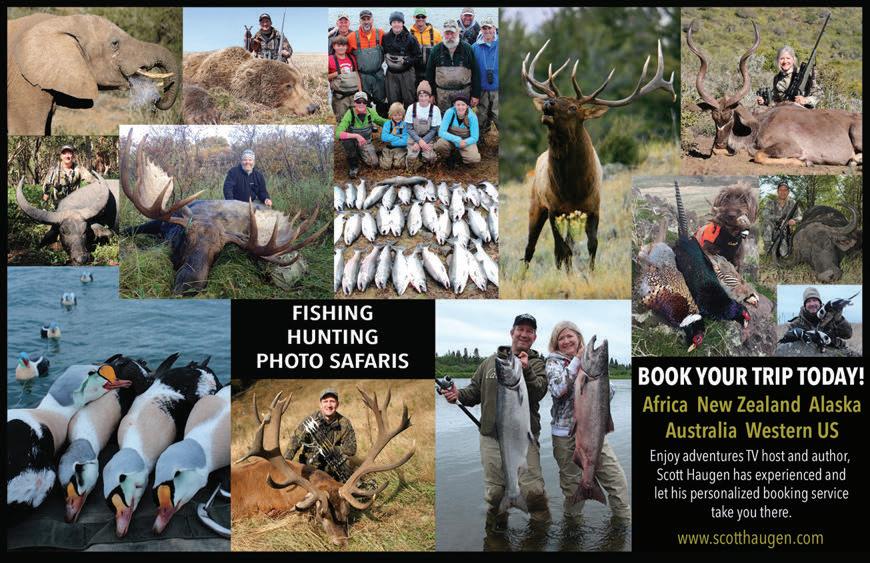
7 minute read
SCOOP AND SCORE
FROM FIELD... SLAM-DUNK CLAMMING
WHAT YOU’LL NEED TO SCORE SOME TASTY SEASIDE TREATS
By Scott Haugen
Clamming offers one of the highest returns on investment for outdoor enthusiasts. With just a license and some basic gear, you’re well on the way to experiencing what clamming and its
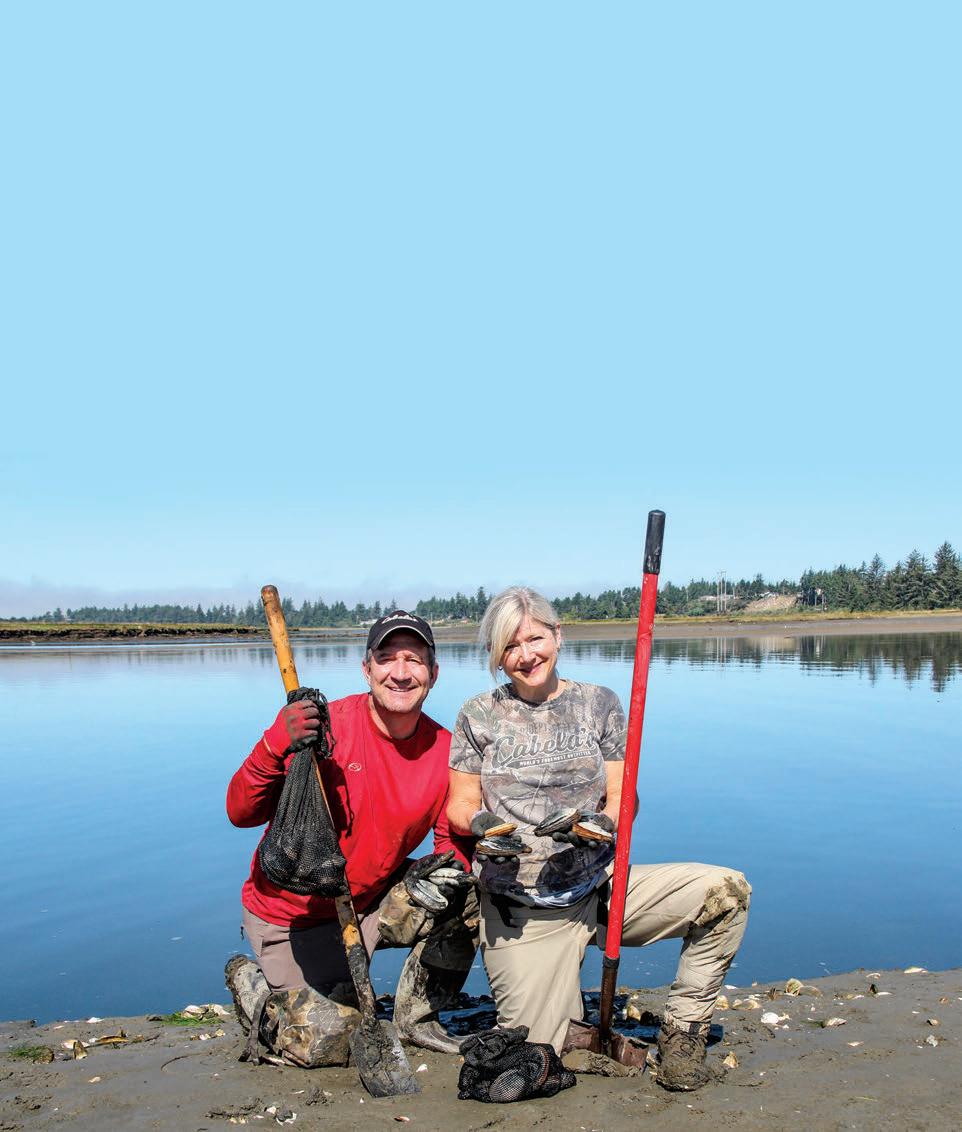
benefits are all about.
When compared to other forms of fishing, clamming is among the most basic and cost-effective. Most people already have the gear needed to successfully clam, and with the purchase of a shellfish or clamming license, that’s all that’s needed to have a fun, productive day. Here’s a look at other gear a clammer may find useful, depending on what species they’re targeting:
TIDE BOOK A tide book shows the year-round tidal changes in every region along
Softshell clams are among the most abundant, easy-to-dig clams along the Pacific Coast. Authors Scott and Tiffany Haugen are pleased with limits they dug in a mudflat during a minus tide. (SCOTT HAUGEN)

... TO FIRE
Clam meat can be used in multiple dishes. Once you get through the cleaning process you’ll be rewarded with a great meal. (TIFFANY HAUGEN)
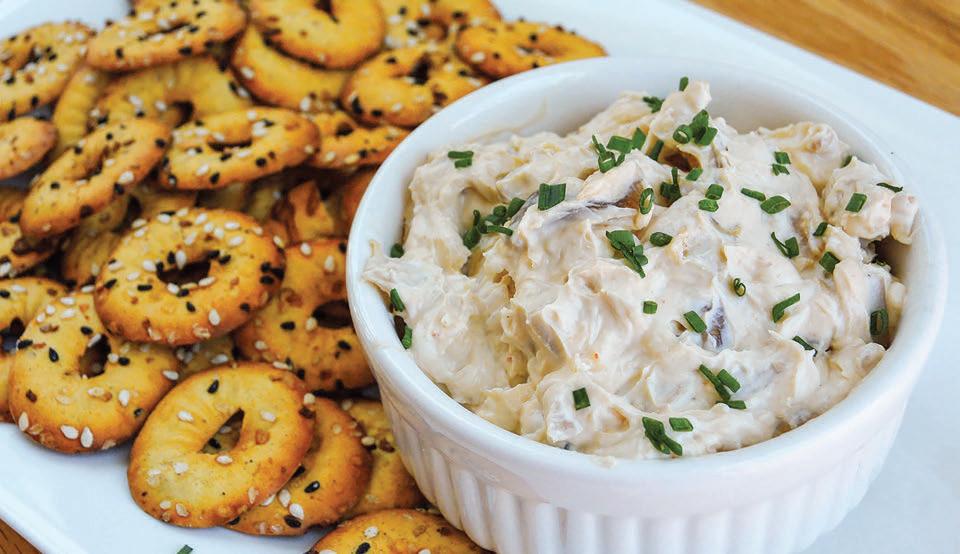
YOU’LL DIG THIS CLAM RECIPE
By Tiffany Haugen
Clams are some of the tastiest bounties the sea has to offer. While the digging is fun, the cleaning can be tedious at times, but it’s worth the effort in order to maximize the
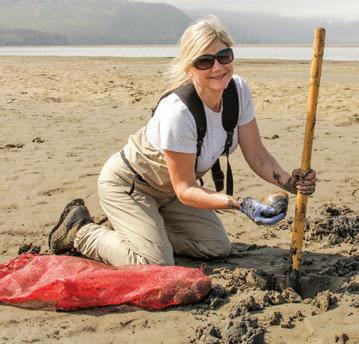
flavor of the clam meat.
Prior to cooking any clams, make sure the meat is free of sand and that any skin and dark portions of meat are removed.
Clam meat can be prepared many ways. This recipe is a family favorite, as we simply enjoy smoking a lot of our fish and game meat.
1 cup smoked clams*, chopped 8 ounces cream cheese, softened 1 tablespoon Worcestershire sauce 1 tablespoon freshly squeezed lemon juice 1 teaspoon minced garlic 1 teaspoon hot chili sauce (sriracha) Fresh chives or green onion, optional should be brined first. To brine clams, place in a shallow dish and sprinkle 1 cup clams with 1½ teaspoons Morton TenderQuick (or a mixture of 2 teaspoons salt and 2 teaspoons sugar) and let sit for 20 minutes.
Rinse, pat dry and place on mesh racks in a cold smoker or a barbecue with a cold smoke generator attached. Cold smoke one to two hours and then cook smoked clams 15 minutes at 250 degrees. To hot smoke clams, place on a wire mesh rack and smoke one hour at 165 to 170 degrees.
In a medium bowl, whip cream cheese with Worcestershire, lemon juice, garlic and chili sauce. Gently fold in clams and stir until combined. Garnish with fresh chives or green onion. Keep refrigerated until ready to serve. *Clams can be hot or cold smoked but Editor’s note: For signed copies of Tiffany Haugen’s b e s t - s e l l i n g c o o k b o o k , Cooking Seafood, visit tiffanyhaugen.com.

the Pacific Coast. Tide tables are available online, but having a hard copy is great for quick reference. Keeping a copy at home, in the car and in the boat is a good idea.
Tide books change each year and are available at local marinas and most sporting good stores. Tide monitoring websites for California can be found at tides.net/california and saltwatertides .com/dynamic.dir/californiasites.html.
SHOVEL The most widely used clamming tool is a garden shovel. But specially designed clam shovels are a must when it comes to razor clams. These narrow-bladed shovels also work well for digging some bay clams.
When digging bay clams, where large amounts of substrate must be excavated, a regular garden shovel is useful. Note, when creating piles of sand, mud or other substrates, flatten them out before leaving the area so clams beneath them don’t suffocate. RAKE A rake is often used when going after bay clams and cockles. A simple steel garden rake will suffice, but many clammers prefer longer prongs to dig deeper into the substrate. Some clam rakes have a basket attached to them to help gather the clams.
BASKET, BAG OR BUCKET Specially made clamming bags are ideal for stowing your catch while digging, especially in beach and bay settings where you’re wading in water. Burlap bags and buckets also work. Take note of state rules regarding the requirement of each clammer to carry their own catch and transport vessel. If hitting the road this summer, note that some states prohibit clammers from digging and gathering clams from the same hole.
CLAM TUBE/GUN There are two types of clam tubes, or clam guns: a fixed tube and a
Clamming requires minimal gear, but what you need depends on the species you’re targeting and where you’ll be digging. (SCOTT HAUGEN)
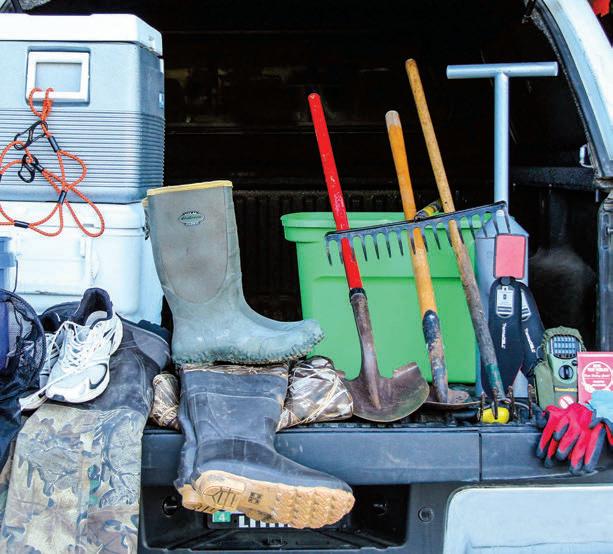

California has no shortage of places to dig the state’s many varieties of clams. Here are some options to consider. (STATE OF CALIFORNIA)

pump-action tube. The fixed tube is a cylindrical piece of metal with a handle and small hole on the top end. As you push the gun into the sand, leave the hole in the top open, pushing and twisting with the "show" – the clam’s breathing hole – centered. When you’ve reached a foot or so in depth, place a thumb over the hole in the gun and use your legs to lift the gun and its sandy contents. Empty the sand to the side and search for a clam. If no clam is found, repeat the process.
A pump-action clam gun is smaller in diameter than the fixed cylinder style, and some states have laws that clarify what minimum diameter the tube should be. If using a clam gun for razor clams, position the show one-third from center, toward land. This will allow two-thirds of the cylinder to extend toward the ocean, which increases the odds of finding a clam since they burrow at a slight angle toward the sea, not straight down.
GLOVES AND COOLERS Clamshells are sharp and fragments are routinely encountered when digging and reaching into substrates. Wearing rubber gardening gloves, ones that are firm yet flexible enough
to offer dexterity, is a good idea.
If transporting clams home to clean, they must be kept alive, and this is easy to do by adding fresh saltwater to a big cooler. An attached aerator provides oxygen so clams don’t suffocate.
WHERE TO GO When it comes to finding a place to clam there are no secrets. If new to clamming, arrive at the bay of choice at least two hours prior to the peak of the low tide, see where fellow clammers are congregating and join the crowd.
Check state-specific clamming regulations and updates as to the beaches and estuaries offering the best clamming. Sometimes emergency closures and short notice openings occur on individual beaches. It’s your responsibility to be aware. This link will help: dfg. ca.gov/marine/mapregs6.asp.
California’s top razor clamming beaches are found in Humboldt and Del Norte Counties. Historically, Clam Beach has been the top razor spot.
Littleneck clams can be found along the entire California coast, with Bodega and Tomales Bays being the top areas around the Bay Area. Further south, the Pismo clam is one of the largest found in California, with the best digging occurring just south of Pismo Beach.
The best digging for butter clams is found in the tidal estuaries north of Humboldt Bay. Another species known as Washington or butter clams, along with gapers, are commonly targeted in Humboldt Bay, Bodega Bay, Tomales Bay, Drakes Estero, Elkhorn Slough and Morro Bay.
The largest clams in the world, geoducks, are hard to dig but can be found in Drakes Estero, Tomales Bay, Bodega Bay and Humboldt Bay on low minus tides.
Softshell clams are found in most bays, estuaries and river mouths north of San Francisco, with some of the best digging to be had at Drakes Estero, Bodega Bay, Humboldt Bay, Lake Earl and Ten Mile Creek. The inlets of the Navarro, Big and Eel Rivers also have softshells.
THE REWARD With some simple gear and a bit of homework you’re on the way to experiencing what clamming is all about. Like anything outdoors, the more you do, the more you’ll learn. And when it comes to clamming you’ll likely want to do it for years to come. CS
Editor’s note: For a signed copy of Scott Haugen’s $10 pocket guide on clamming, including how to clean and cook them, visit scotthaugen.com. Follow Scott on Instagram and Facebook.
